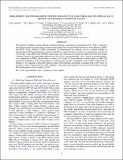HIGH-ENERGY ELECTROMAGNETIC OFFLINE FOLLOW-UP OF LIGO-VIRGO GRAVITATIONAL-WAVE BINARY COALESCENCE CANDIDATE EVENTS
Author(s)
Blackburn, Lindy L.; Briggs, Michael S.; Camp, J.; Christensen, N.; Connaughton, V.; Jenke, P.; Veitch, J.; Remillard, Ronald A; ... Show more Show less
DownloadBlackburn-2015-HIGH-ENERGY ELECTROM.pdf (2.242Mb)
PUBLISHER_POLICY
Publisher Policy
Article is made available in accordance with the publisher's policy and may be subject to US copyright law. Please refer to the publisher's site for terms of use.
Terms of use
Metadata
Show full item recordAbstract
We present two different search methods for electromagnetic counterparts to gravitational-wave (GW) events from ground-based detectors using archival NASA high-energy data from the Fermi Gamma-ray Burst Monitor (GBM) and RXTE All-sky Monitor (ASM) instruments. To demonstrate the methods, we use a limited number of representative GW background noise events produced by a search for binary neutron star coalescence over the last two months of the LIGO-Virgo S6/VSR3 joint science run. Time and sky location provided by the GW data trigger a targeted search in the high-energy photon data. We use two custom pipelines: one to search for prompt gamma-ray counterparts in GBM, and the other to search for a variety of X-ray afterglow model signals in ASM. We measure the efficiency of the joint pipelines to weak gamma-ray burst counterparts, and a family of model X-ray afterglows. By requiring a detectable signal in either electromagnetic instrument coincident with a GW event, we are able to reject a large majority of GW candidates. This reduces the signal-to-noise ratio of the loudest surviving GW background event by around 15–20%.
Date issued
2015-03Department
MIT Kavli Institute for Astrophysics and Space ResearchJournal
The Astrophysical Journal. Supplement Series
Publisher
IOP Publishing
Citation
Blackburn, L., M. S. Briggs, J. Camp, N. Christensen, V. Connaughton, P. Jenke, R. A. Remillard, and J. Veitch. “HIGH-ENERGY ELECTROMAGNETIC OFFLINE FOLLOW-UP OF LIGO-VIRGO GRAVITATIONAL-WAVE BINARY COALESCENCE CANDIDATE EVENTS.” The Astrophysical Journal Supplement Series 217, no. 1 (March 1, 2015): 8. © 2015 The American Astronomical Society
Version: Final published version
ISSN
1538-4365
0067-0049